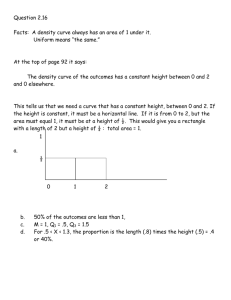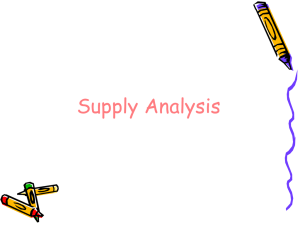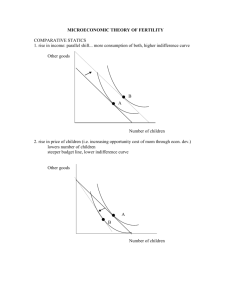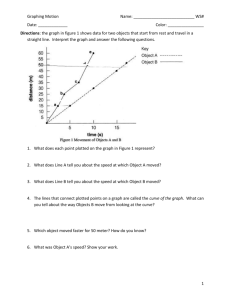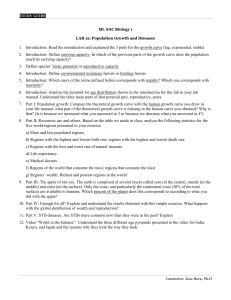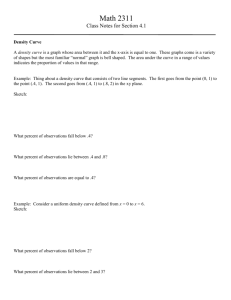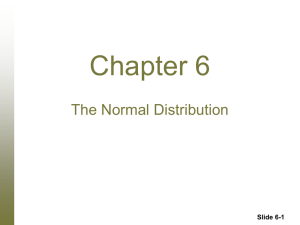Rybczynski
advertisement
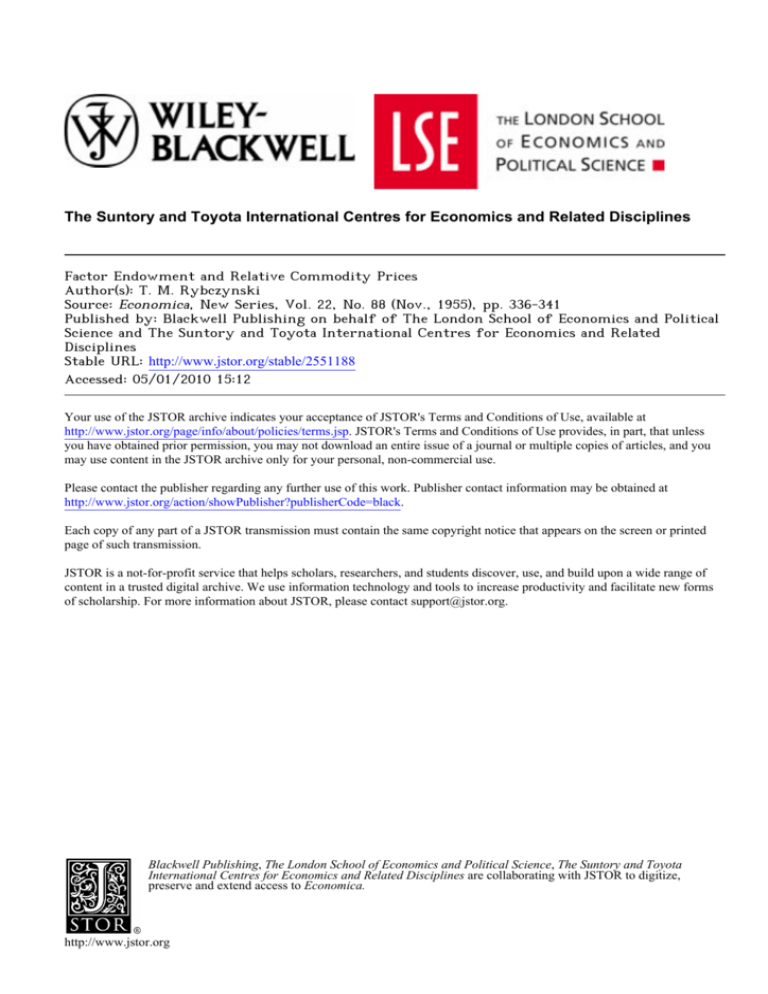
The Suntory and Toyota International Centres for Economics and Related Disciplines Factor Endowment and Relative Commodity Prices Author(s): T. M. Rybczynski Source: Economica, New Series, Vol. 22, No. 88 (Nov., 1955), pp. 336-341 Published by: Blackwell Publishing on behalf of The London School of Economics and Political Science and The Suntory and Toyota International Centres for Economics and Related Disciplines Stable URL: http://www.jstor.org/stable/2551188 Accessed: 05/01/2010 15:12 Your use of the JSTOR archive indicates your acceptance of JSTOR's Terms and Conditions of Use, available at http://www.jstor.org/page/info/about/policies/terms.jsp. JSTOR's Terms and Conditions of Use provides, in part, that unless you have obtained prior permission, you may not download an entire issue of a journal or multiple copies of articles, and you may use content in the JSTOR archive only for your personal, non-commercial use. Please contact the publisher regarding any further use of this work. Publisher contact information may be obtained at http://www.jstor.org/action/showPublisher?publisherCode=black. Each copy of any part of a JSTOR transmission must contain the same copyright notice that appears on the screen or printed page of such transmission. JSTOR is a not-for-profit service that helps scholars, researchers, and students discover, use, and build upon a wide range of content in a trusted digital archive. We use information technology and tools to increase productivity and facilitate new forms of scholarship. For more information about JSTOR, please contact support@jstor.org. Blackwell Publishing, The London School of Economics and Political Science, The Suntory and Toyota International Centres for Economics and Related Disciplines are collaborating with JSTOR to digitize, preserve and extend access to Economica. http://www.jstor.org [NOVEMBER Factor Endowment and Relative Commodity Prices' By T. M. RYBczYNsIu 1. The purposeof this note is to investigatethe effectof an increase in the quantityof a factorof productionuponproduction,consumption and the termsof trade. Althoughin the model used here the quantity of only one factor is varied, the analysis can easily be extendedto variationsin the quantities of two factors-the variationsin these factorsbeing proportionateor disproportionate. 2. We assumea closedeconomywithonlytwo factorsof production, X and Y, which are perfectlydivisible,perfectlymobile, and in some degreesubstitutable. There are but two industriesand each of them is subject to a linear homogeneousproductionfunction. They are producingtwo commoditiesL and R. The " factorintensity" of each industry is different.By this we mean that technical conditions of productionare such that the ratiomarginalphysicalproductof X is marginalphysicalproductof Y alwaysequalisedas betweenthe two industriesby using a higherratio of - y in one of the industries(the X-intensiveindustry)and a lower ratio of - in the other(the Y-intensiveindustry). y 3. We shall use the box diagram as employed by Stolper and Samuelson2to depict productionconditions. Thus in Fig. 1 the box ABCD depictsan economywith AB of FactorX and AD of Factor Y. Isoquantsfor the commodityL areshownby the familyof curvesconvex to the originA; similarlyisoquantsfor the commodityK are shown by the familyof curvesconvexto the originC. If we make commodityK X-intensiveand commodityL Y-intensive, the contract curve AC must be convex to D. Equilibriummust lie somewhereon this curve. The position on the curve is determined by the conditionthat the substitutionrate betweenL and K in production (as indicatedby the isoquants)must be equal to the substitution rate in consumption(as indicatedby the consumerpreferencesystem). 4. Supposethis condition is fulfilledat the point S. An increase in the quantityof Factor X may be shown by extendingBA to BA'. The new productionbox is now A'BCD'. The horizontalextension 1 I wish to expressmy thanksto Dr. H. Makowerfor valuablesuggestionsregarding the exposition of this paper. 2 See W. F. Stolperand P. A. Samuelson," Protectionand Real Wages ", reprinted in Readingsin the Theoryof InternationalTrade,pp. 347 et seq. 336 1955] FACTOR ENDOWMENT AND RELATIVECOMMODITYPRICES 337 of the box leaves the family of the isoquants originating from C unaffected; the family of isoquants originating previously from A must now be shifted to the new origin A'. As the production functions of both commodities are homogeneous and of the first degree, the line AS intersects all members of the family of L-isoquants at points where their slopes are the same as at the point S; similarly CS intersects all members of the family of K-isoquants at points where these curves have this same slope. Therefore, when the line A'S' is drawn parallel to AS it must cut the family of isoquants originating from A' at points where these curves all have the same slope as the curves at S. FIG 1 X- intensive commodity K D' D factor X C factor y A' A factor X B y- Intensive commodity L Let the line CS be prolonged to cut A'S' at P. Point P must be on the new " contract" curve because the slopes of the two isoquants passing through that point are by the above reasoning equal, both being the same as the slope of the tangent at S. If the same rates of substitution in production were to remain after Factor X had been increased by AA', P would be the new point of equilibrium. 5. Because of the property of linearity of the two production functions, the amount of a commodity produced may be measured by the distance along any given radial from the origin. Thus since the length A'P is necessarily shorter than AS, production of the Yintensive commodity must be less at P than at S. The fact that CP is longer than CS shows on the other hand that production on the X. intensive commodity is expanded. This proves that the maintenance of the same rates of substitution in production after the quantity of one factor has increased must lead to an absolute expansion in production of the commodityusing relatively much of thatfactor, and to an absolute 338 [NOVEMBER ECONOMICA curtailment of production of the commodity using relatively little of the same factor. 6. The above propositionmay now be carriedover into a diagram showing" productionpossibility" curves. Thusin Fig. 2 the horizontal and verticalco-ordinatesmeasurequantitiesof commoditiesK and L respectively. Withthe giveninitialquantitiesof X and Y, the boundary FIG. 2. commodity L / fy-factor intensive) M O N commodity K intensive) (X-factor of possibleL, K, combinations,or the " productionpossibility" curve, is SM. The concavityof this curveto the originconnotesconditions of increasingrate of substitutionon the productionside. 7. The originalposition of equilibriumis definedby the equality of substitutionratesin consumptionand productionand is represented graphically by the point of tangency between the "production possibility" curve and an indifferencecurve (point R in Fig. 2). To find the new point of productionand consumptionequilibrium when the quantity of Factor X is increased, it is necessary to discover the new point of tangencybetween the new " production possibility"curveand (another)indifferencecurve. This requiresthe derivationof the new " productionpossibility" curveand its analysis in relation to the indifferencecurve system. Each will be examined below. 1955] FACTOR ENDOWMENT AND RELATIVECOMMODITYPRICES 339 8. Now in virtue of our proposition that the maintenance of the same substitution rate in production, after Factor X has increased, requiresan absolute increase in the output of the X-intensive commodity, and an absolute reduction in the output of the Y-intensivecommodity, it follows that the slope found at R on the production curve SM (Fig. 2) must, on the production curve ZN, lie below RT where less of L is produced. We shall suppose that it lies at R'. 9. So much for the shape of the new " production possibility" curve. What is its relationship to the system of indifference curves ? We assume the absence of any inferior good. This means that as income increases more of both commodities must be consumed. This in turn implies that for any indifference curve above that passing through R, the slope prevailing at R must be found on a sector of the higher indifference curve which lies within the quadrant URT. Let the indifference curve passing through F have at that point the same slope as at R where F is the point of intersection between OR prolonged and ZN. Then since the new " production possibility " curve above R' is flatter than at R and the indifference curve through F has the same slope as at R, it follows that the indifference curve passing through F must cut the new " production possibility " curve from above at that point. But it also follows that, since below F the indifference curves become flatter, there must be a point of tangency between a (higher) indifference curve and the " production possibility " curve below F, but above R'. At such a point the slope of the " production possibility" curve and indifference curve must be flatter than at R. This implies that the terms of trade of the X-intensive commodity have worsened as against the Y-intensive commodity, and proves the proposition that the terms of trade of the commodity using relatively much of the factor whose quantity has increased must deteriorate. 10. No reference has been made so far to the conditions of demand. The fact that the point F was assumed to fall on the straight line OR was equivalent to the assumption that the Marginal Propensity to Consume is equal to the Average Propensity to Consume (the latter falling over the whole range of the change in the position of equilibrium). The implications arising from the possibility of the former being different from the latter must now be examined. When the Marginal Propensity to Consume the X-intensive good exceeds the Average Propensity to Consume, the income consumption curve will cut the new " production possibility" curve somewhere between T and F. Since it has been proved that the new point of equilibrium must always be below the point where an indifference curve with the same slope as at R (i.e. defined by the income consumption curve) intersects the new "production possibility" curve, it follows that the more the Marginal Propensity to Consume favours the commodity using relatively much of the factor whose quantity has 340 ECONOMICA [NOVEMBER beenincreased,the smalleris the worseningof the termsof tradeof that commodity. The reverseholds equally true: when the MarginalPropensityto Consume the good which uses a relatively low proportion of the increased factor exceeds the Average Propensity to Consume, an indifferencecurvewith the same slope as at R will cut the new " productionpossibility" curvesomewherebetweenU and F, signifyingthat the terms of trade have turned more against the commodityusing relativelymuch of the increasedfactor. The greateris the difference betweenthe Marginaland the AveragePropensityto Consume,the greaterwill be the deteriorationin the termsof tradefor the commodity usingrelativelymuch of the increasedfactor. 11. Ourconclusionis that an increasein the quantityof one factor will alwayslead to a worseningin the terms of trade, or the relative price, of the commodityusing relativelymuch of that factor. The MarginalPropensityto Consumeinfluencesthe degreeof deterioration, but it can neverreverseits direction. 12. Despitethe changeof the relativepricesof the two commodities the patternsof productionand consumptionmay remainunaltered,or changein favourof one good or the other. By the unchangedpattern of productionand consumptionwe mean that the quantityof both productshas increasedproportionately; a shift in the directionof one commodity signifies a greater than proportionateincrease in productionand consumptionof that good combinedwith a less than proportionaterise of the other. The new equilibriumis determined againby the differencebetweenthe Marginaland the AveragePropensity to Consumeon the one handand the shift of the productionpossibility curve; the latter in turn is determinedby the proportion in which one factor has been increasedand the technical production functionsof the two commodities. The unequivocalgeneralisationpossibleregardingthe new production and consumptionpatternsis that they will changein the direction of the good using relativelymuch of the factor increased(i.e. the quantity of that good produced and consumed will increase more if the Marginal whilethat of the otherwillriseless thanproportionately) Propensityto Consumethe productusingrelativelymuchof the factor increasedremainsequal to, or is greaterthan, the AveragePropensity to Consume. When the Marginal Propensityto Consume is less than the Averagethen the new productionand consumptionpatterns may still changein favourof the commodityusing much of the factor increased,or may remainunchangedor move in the directionof the othergood; the ultimateoutcomedepends,in this case,on thenumerical values assignedto the factors mentioned; it is possible,however,to offer tentativeconclusionsthat the small excess of the Marginalover the AveragePropensityto Consumein the directionof the good using little of the factor increasedis still likely to shift the productionand 1955] FACTOR ENDOWMENT AND RELATIVECOMMODITYPRICEs 341 consumptionpatternsin favourof the othercommodity; a moderate excess is likely to leave the productionand consumptionpatterns unchanged,while a large differencemay be expectedto alter both productionand consumptionin favourof that good. All this is but a corollaryof our previousproof. 13. If it is now assumedthat the commodityusingrelativelymuch of the factor, the quantityof which had been increased,is an item of export, this means that externalterms of trade will deteriorate; conversely,should the commoditybe an import, the terms of trade mustimprove. The London School of Economics.
